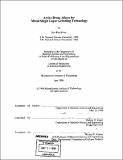Active braze alloys for metal single layer grinding technology
Author(s)
Shiue, Ren-Kae
DownloadFull printable version (17.56Mb)
Other Contributors
Massachusetts Institute of Technology. Department of Materials Science and Engineering.
Advisor
Thomas W. Eagar.
Terms of use
Metadata
Show full item recordAbstract
Components made of high-performance ceramics or superalloys are subject to strict requirements with regard to their geometric and dimensional accuracy. The surface finish and edge zone characteristics have a large effect on the component's performance. These requirements can not be met directly by the sintering process used in the manufacture of ceramic materials or traditional casting of superalloys. Grinding is both technically and economically the number one choice when one has to consider machining these materials. Metal Single Layer (MSL) grinding technology provides an alternative way to make use of the superabrasives, diamond and CBN, in grinding these materials. One of the primary challenges in MSL grinding technology is to develop suitable active braze alloy(s) which can bond the superabrasive grits. Ticusil (Ag-Cu eutectic+4.5 wt% Ti) and 70Cu-21Sn- 9Ti (wt%) are two of the currently used active braze alloys. The primary failure mode of these two MSL wheels in the grinding test is transverse fracture and debonding of the diamond grits. The high applied load is responsible for transverse fracture of the diamond grit, and the intermetallic phase existing at the interface between the diamond and the braze alloy is one of the causes of the debonding of the diamond grits. Also, a finite element analysis shows that most of the residual thermal stresses and the thermal mismatch strains are localized at the diamond/braze alloy interface. This results in potential weakness of this area. Moreover, the inherent defects, such as voids, and the brittle intermetallics in the interface can cause crack initiation and propagation. Both deteriorate the life of the grinding wheel. The failure of the braze alloy can be divided into two categories. If the grinding process is very abrasive, such as green concrete grinding, the wear resistance of the braze dominates the fracture of the braze alloy. On the other hand, failure of the braze alloy can also result from cracks at the interface. In such a case, the fatigue resistance of the braze alloy plays an important role in determining the wheel's life. The wear resistance of the braze alloy can be improved by introducing suitable hard particles. It was found that a braze alloy of 77Cu-23Sn-12.5Ti-7.5Zr-10TiC-0.2C (by weight) exhibits excellent performance in a wear test (a ten fold improvement), which is further confirmed in the grinding test (a two fold increase in life). The fatigue resistance of the active braze alloy can be modified by either reducing the volume fraction of the brittle intermetallic phase in the braze and/or enhancing the ductility of the braze alloy matrix. A ductile active braze alloy can be achieved by combining the two-layer structure and two step brazing process. To aid dissolution and diffusion of the Cu atoms into the Cu/Sn/Ti braze alloy, a lower volume fraction of the intermetallic phase and higher ductile matrix of the braze can be achieved. Both have beneficial effects in modifying the ductility of the active braze alloy, and make removal of the braze alloy from the substrate by acid etching easier.
Description
Thesis: Ph. D., Massachusetts Institute of Technology, Department of Materials Science and Engineering, 1996. Vita. Cataloged from PDF version of thesis. Includes bibliographical references (pages 144-153).
Date issued
1996Department
Massachusetts Institute of Technology. Department of Materials Science and EngineeringPublisher
Massachusetts Institute of Technology
Keywords
Materials Science and Engineering.